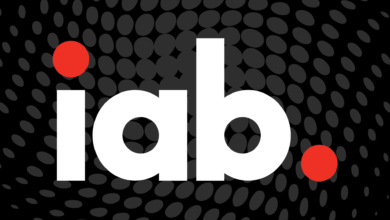120 Presentation Topic Ideas to Help You Hook Your Audience

I recently did a presentation night with my friends. If you’re unfamiliar with the concept, it’s when a group of friends gets together to share presentations they created about a topic of their choice.

The topics are typically light-hearted and fun. For example, mine was “my friends as obscure animals.”
You would be surprised how difficult it was to develop ideas for something as silly and unserious as a social presentation night.
So, it’s naturally even harder to ideate presentation topics for a professional setting with the pressure of needing to impress, influence, educate, or entertain.
I will share how to develop thought-provoking and relevant topics for your presentations to ensure they are memorable and resonate well with your audience.
Table of Contents
How to Choose a Great Presentation Topic in 5 Steps
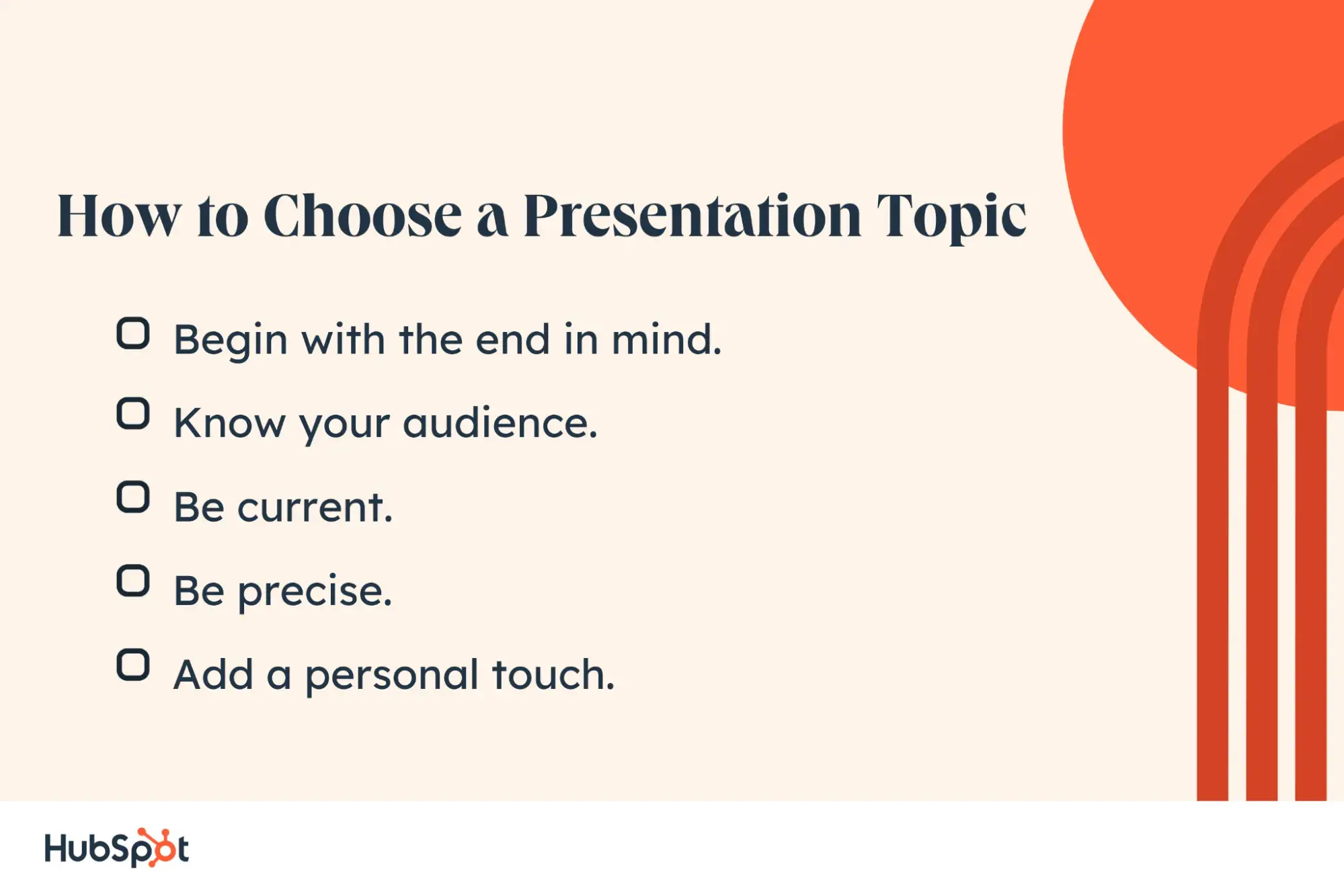
I’ve broken down the painstakingly long process of choosing a topic into five simple and easy steps. Let’s walk through it.
Step 1: Begin with the end in mind.
“Some things are better left unsaid” is what I don’t want people to say about my presentations. That’s why I always have a specific goal before choosing a topic.
Some questions I ask myself are:
What do I hope to achieve from the presentation?
How do I want to come across?
What do I want my audience to take away from the presentation?
Having a solid goal helps me begin crafting the title of my presentation. For instance, if I’m presenting a seminar about AI, my goal might be to convince my audience to incorporate more AI into their daily lives.
A punchy idea for a title could be “Why AI Is NOT Ruining Your Life.”
Step 2: Know your audience.
Let’s say I’m preparing an internal presentation for my team at Nickelodeon. I would first consider my audience’s experience and interests.
I don’t want to present something they already know well or have the topic go over their heads. Since it’s my team, I would feel confident that these factors overlap comfortably with mine.
If you’re presenting to an unknown audience, research the individuals or general demographic if specific names aren’t available.
Next, I’d consider what style is preferred. Some workplaces might be more formal, requiring a serious presentation tone.
Based on the type of content we work on at Nickelodeon, we keep things light at work, so I’d integrate humor and a casual tone into my presentation.
Pro tip: Always consider your audience’s knowledge level on the topic before drafting your presentation. For example, a presentation on social media targeted at Gen Z will differ from that targeted at Millennials.
Step 3: Be current.
Of presenters, 47% tailor their presentation topics to current events, which is an easy way to ensure the topic is novel.
I’m not saying the presentation has to be completely centered around a current event. Even including certain references or themes can alert audiences that this isn’t a cut-and-paste presentation that’s been done before.
For instance, if I were giving a presentation to my team at Nickelodeon, I might slip in a humorous reference to the 2024 film Wicked since it’s very culturally relevant.
If I wanted to tailor my entire presentation to this topic, I could highlight some of the ways the PG-rated movie manages to capture hearts of all ages, which is relevant to our team’s family-friendly content.
Step 4: Be precise.
Completing these first three steps puts me in a place with decent topic ideas. Now, I can cut out the excess and select a niche topic with a specific goal.
This is imperative because the broader the topic, the more difficult it will be for my audience to take away key ideas and actionable tips. Also, it would be more difficult to gather an audience intrigued and excited by my topic.
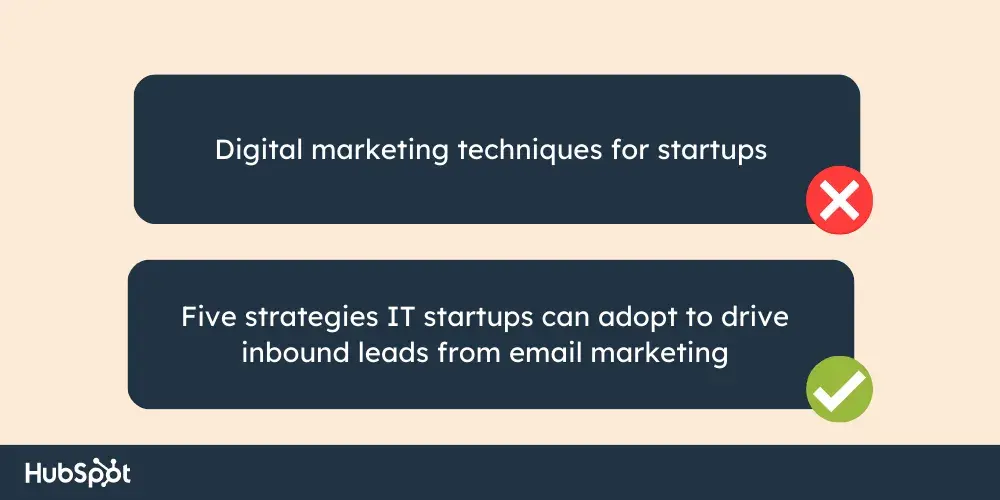
For instance, the first topic in the image is generic, sounds vague, and doesn’t specify any clear benefits. On the other hand, the second topic mentions the target audience, tells them what to expect, and provides a clear, actionable plan.
The audience knows exactly what they will take away from the presentation.
Step 5: Add a personal touch.
Presentations with stories are 22 times more likely to be remembered than those with straight facts. Such is the power of narrative and personalization in storytelling.
Therefore, I always consider topics I can tie back to myself, which also helps the presentations feel more authentic. There are a few ways I would do this:
Pick a topic I have first-hand experience with.
Provide a unique opinion or learnings/findings to add value to my words.
Let the audience view a controversial topic from my perspective.
Choose a topic I’m genuinely passionate about.
Tell a personal story that functions as a metaphor for my topic.
Pro tip: Think about where your interests and professional experience meet. Then, narrow these topics or themes down to 2-5 driving factors to focus on in your presentation.
120 Presentation Topic Ideas
Below is an extensive list of presentation ideas from personal experiences to digital marketing and AI. I always reference this list when I find myself in a rut.
I can keep the framework and swap out keywords for many of these titles, providing an infinite combination of ideas.
Presentation Topic Ideas for Personal Experiences
The failures that made “Me”
My journey balancing full-time and freelance work
How I made social media a productive space
Five life-changing habit changes I made this year
How I got out of my longest writing rut
My battle with Covid-19
How I turned my weaknesses into strengths
Coping with anxiety and depression
Leveraging my hobbies to improve my career
Remote vs. in-office: Where do I thrive?
What I wanted to be and what I became
How I rediscovered myself after hardship
Presentation Topic Ideas for Controversial Issues
Future of genetically modified food and preservatives
Privacy in the age of AI: Ethical issues
The power of social media in politics
Freedom of expression or harmful content
Navigating the line between cultural appropriation and appreciation
What can we do to prevent climate change?
Women’s rights are everyone’s rights
LGBTQ Rights: Balancing equality and tradition in the future
The ethics of animal testing
The implications of social media for future generations
How much screen time is too much?
Punishment vs. rehabilitation
Presentation Topic Ideas for Current Trends
Five small efforts to fight climate change
How local politics play into the big picture
What are blockchain and cryptocurrencies?
The latest fitness trends of 2024
Life on social media vs. real life: How to keep yourself sane
Water scarcity and conservation
Renewable and sustainable energy sources: Are we ready?
The benefits of mindfulness and meditation practices for new moms
Understanding and addressing mental health issues in Gen Z and Alpha.
12 Techniques for practicing self-care and self-compassion
Transitioning back to hybrid or full-time office models after years of remote work.
How X marketers grow their personal brands (and their ROIs)
Presentation Topic Ideas for Industry Insights
How new AI technologies are changing the industry: 5 examples
Six key trends and industry forecasts for the future
How to overcome these 10 challenges to succeed
Measuring and optimizing organizational marketing efforts using AI
Using predictive analytics to extract key marketing insights
13 strategies to increase customer loyalty and retention
Improve your online visibility and traffic: 15 tips from LinkedIn gurus
Seven ways to create engaging video content for your company
Five ways for businesses to build a strong social media presence
Which social media channels are best for your brand?
Is AI revolutionizing the retail industry?
Digital learning and the future of traditional learning systems
Presentation Topic Ideas for Digital Marketing
The next big thing in digital marketing — unlocked
The art of storytelling in marketing: 23 businesses that kill it
Benefits of cross-channel marketing for software development companies
Voice search and its impact on digital marketing in 2025
Maximizing ROI for your startup marketing: 3 underestimated tactics
Changes in consumer behavior: Reasons and implications
Importance of personalization in digital marketing
10 Emerging marketing trends and technologies
Designing an effective mobile strategy for your business
Importance of infographics in content marketing: HubSpot’s case study
Creating effective marketing funnels for health products
The power of user-generated content for companies
Presentation Topic Ideas for AI
Six top stories about AI in 2024
Five weird, but true, facts about AI
What these three business experts are saying about AI
Three shocking ways AI can make you a better marketer
The Dark Side of AI
How do presidential campaigns benefit from AI?
Five AI tools every marketer needs
AI and Big Data: Changing the landscape of modern business
Which jobs will AI replace?
Why do these X celebrities and industry leaders love AI?
AI in human resources: Recruiting and talent management
The Ethics of AI: Balancing business interests and societal impacts
Presentation Topic Ideas for Sales
Cold calls: Unethical tactics and grey areas
Sales: Expectations vs. Reality
Sales prospecting made simpler with AI
Sales calls: Do’s, Don’ts, and Musts
Six sales strategies you need to throw out the window
Five skills every salesperson needs to develop in 2024
Building long-lasting relationships with customers using these three tried and tested methods
Dealing with rejections: Five ways and one bonus tip
Patient waiting and seven ways to deal with it
13 effective sales strategies for building relationships and closing deals
Developing effective sales training programs for new hires
20 effective sales communication strategies
Presentation Topic Ideas for Time Management
How to achieve an ideal work-life balance for remote workers
How much time should you ideally spend networking on LinkedIn?
How to effectively delegate tasks
Buy back your time: Ways and benefits
Six business principles of time management
How to make an effective plan: Three practices you can start today
15 ways to improve personal efficiency and productivity
The five steps of the Pomodoro Technique
Goal setting and prioritization: For IT start-ups
Nine best multitasking strategies of insanely successful businesspeople
Time management for busy professionals: Where to start?
Stop procrastinating: Eight ways starting tomorrow
Presentation Topic Ideas for IT
Advantages and risks of adopting cloud software
Open-source software: seven best practices
Machine learning: Pros and cons for marketing
How to create user-friendly interfaces for software and websites
The role of IT in digital transformation
The Internet of Things: five opportunities for businesses and consumers
Six ways to protect your digital assets
Seven benefits and three risks of moving to the cloud
How does Big Data work?
Best strategies to protect organizational data: five tried and tested techniques
Technology and its impact on society and culture
Mobile device management: Where to start?
Presentation Topics Ideas for Business
Optimizing collaborations to save time across all departments
Eight time management tools and apps for businesses
12 common skills of successful businesspeople
10 tips and techniques for a successful marketing strategy
Harnessing the power of influencer marketing
Allocating a marketing budget to maximize ROI in five steps
Five manufacturing techniques to minimize costs
Understanding ethical issues in business and marketing
15 ways to reduce your company’s carbon footprint
Three old business models making a comeback
Seven ways X developed a strong company culture
12 strategies for building a sustainable and responsible business in 2023
5 Presentation Tips
While I’ve stressed the importance of using presentation topics to put audiences first, offer direct solutions, and fill in knowledge gaps, there’s more.
After all, the part that usually keeps me up the night before a big presentation isn’t typically the topic but the thought of actually presenting.
That’s why I’m sharing my five best tips to help you ace your next presentation.
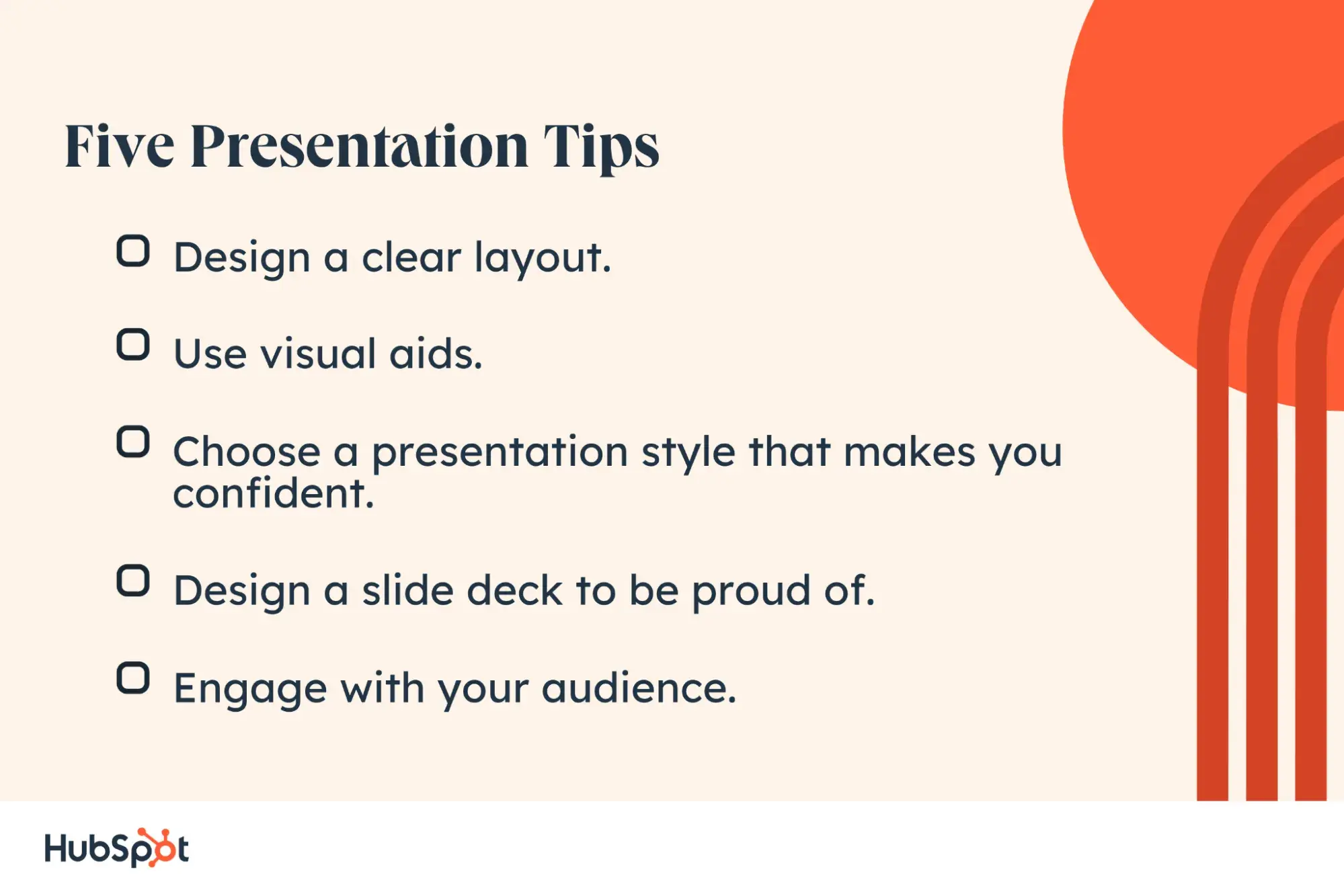
1. Design a clear layout.
I like to organize my presentations into four clear sections — introduction, body, conclusion, and follow-up — to help me construct a clear layout and attractive design. Here’s what I include in each area:
Introduction
A catchy title with a hook
A thesis statement or big idea behind the presentation
Table of contents that gives my audience a preview into what’s coming
Body
A clear explanation of my topic
My argument, perspective, or main message I’m trying to convey in three to five key points
Facts expertly interspersed to help bolster my claims
Conclusion
A concise summary of the main points and takeaways
A catchy line to inspire thought-provoking, vivid discussions.
Follow-Up
Five to ten minutes at the end of my presentation for a Q&A, where I can dispel doubts and provide more context to my audience
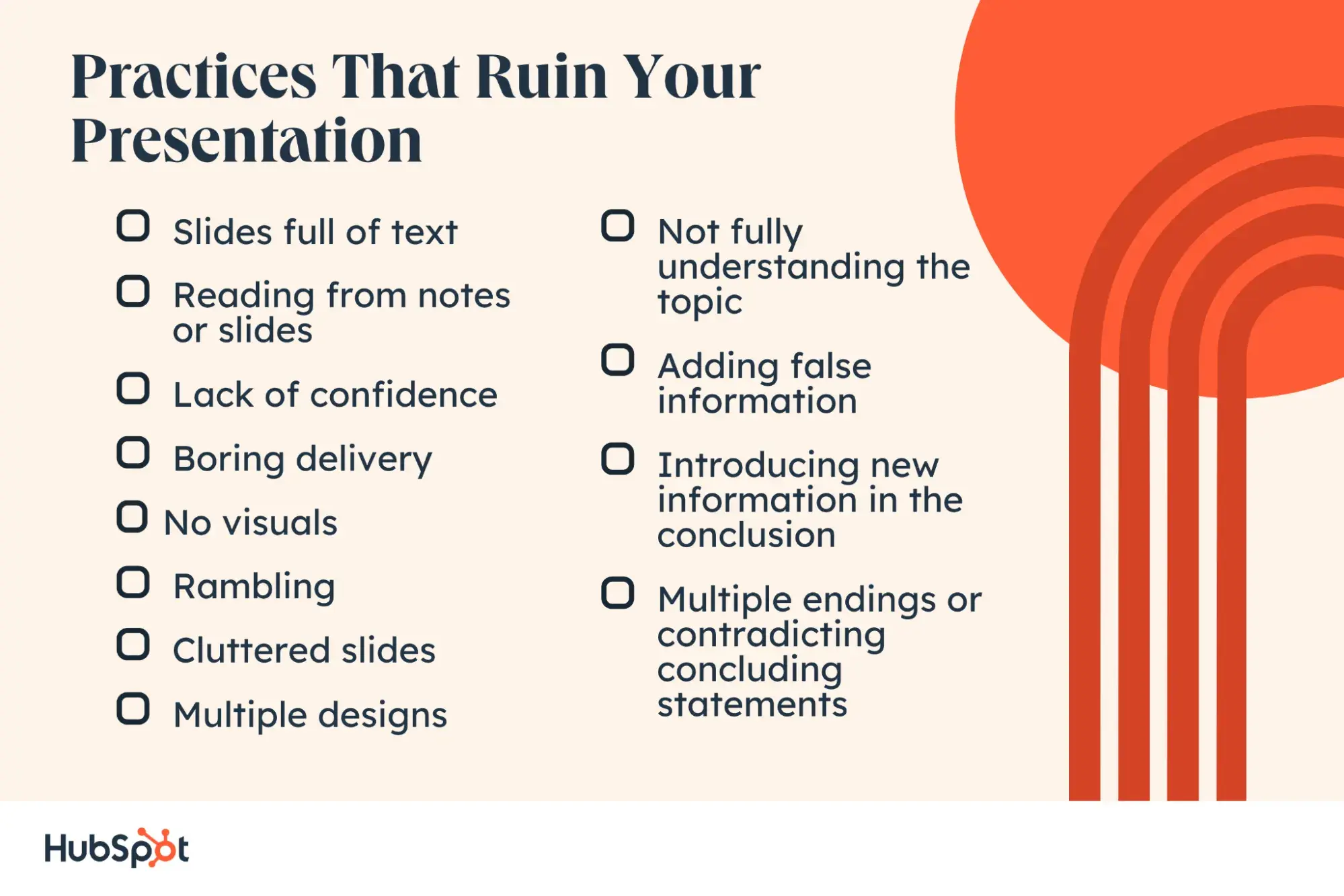
2. Use visual aids.
I hate to admit it, but nothing makes me zone out quicker than a black-and-white, word-heavy presentation. My lower attention span and visual learning preference make it hard to focus on a strictly verbal or text-based presentation.
Presentation visuals can increase content engagement by up to 80%.
LinkedIn also provides several reasons supporting the importance of visual aids, such as capturing the attention and interest of audiences, reducing cognitive load by breaking down complex concepts, and increasing the retention and recall of verbal messages.
I work full-time in media and entertainment, so it’s easy to add visuals to my presentations in the form of key art, video promos, and character art.
However, even in less creative industries, visual aids like charts and graphs, varied color schemes, and even brand logos can help break up the text.
3. Choose a presentation style that makes you confident.
I know my strengths and weaknesses best when it comes to presentation skills. I know I’m not the best at getting a high volume of information across quickly, but I have an exemplary memory (no speaker notes here!) and ease of communication.
All this self-knowledge helps me prepare presentation styles that make me feel most comfortable and confident. Presentation topics can also dictate what style is best.
For instance, if my topic is “Five life-changing habit changes I made this year,” I’ll likely adopt a storytelling style. On the other hand, a topic like “The Ethics of AI: Balancing business interests and societal impacts” might call for an instructor style.
The moral is to choose a way of presenting the material that makes me feel most confident. The actual information may be difficult, but how I share it can be simple.
4. Design a slide deck to be proud of.

I live by the phrase “look good, feel good.” If I’m sick, exhausted, or just having a bad day, staying in pajamas and unwashed hair makes me feel worse than I am. But showering and wearing my favorite outfit can turn my entire day around.
The same theory applies to presentations. I’ve had to turn around last-minute presentations on sloppy slides, and feeling embarrassed about the appearance can be enough to throw me completely off.
This makes sense since 91% of professionals feel more confident presenting a well-designed slide deck.
My company uses branded slide templates, which eases the process, but manually going in to make the fonts, colors, text spacing, and visuals look good is imperative.
You can also use presentation templates to save time and discover beautiful, engaging designs.
It’s also important to practice running through these well-designed slides, especially if you’re driving the deck for a group presentation. Walk through the presentation in Slideshow mode and ensure everything looks as desired.
5. Engage with your audience.
Typically, my biggest fear leading up to a presentation is ensuring that I relay all the information I have prepared.
However, I should be more worried about creating a strong enough connection with my audience that my presentation resonates in their minds long after.
Of audiences, 79% prefer interactive presentations with opportunities to get involved, so presenters have used tools like polls and quizzes to increase audience engagement by 40%.
This is also a great way to alleviate some of the pressure from myself — by throwing to the audience at times, I can make the presentation feel more conversational.
Here are a few ways that my colleagues and I have made presentations more interactive:
Start by asking uncommon questions to the audience. Involve them from the get-go, saying things like, “Raise your hands if X.”
Add polls to the slides and call on audience members to share their responses.
Make eye contact to build credibility and show confidence. Don’t stare at the slides or notes. Smile occasionally and talk to the audience directly.
Share a personal perspective and ask if anyone in the audience agrees or disagrees. Call on them to share why.
Use active and confident body language. Don’t stand in the same place the entire time. Move around the stage.
Ask close-ended questions in between to keep the audience engaged without losing time. Address them using their names to keep things interesting.
Share personal experiences and stories that your audience will find fascinating and relatable.
Feeling Inspired Yet?
As a younger professional in my industry, I’m always looking for ways to make myself known, stand out from the crowd, and prove my ability to be a leader.
This blog post taught me that unique, memorable presentation topics can help me accomplish these goals.
We all have a wealth of expertise, experience, and personality, and that’s enough to create a story worth hearing. So the question is not “What should I say?” but rather “How can I say it?”
My most important takeaway is that authenticity comes from finding ways to personalize presentation topics.
Even something data-driven or industry-focused has the opportunity for a reference to an anecdote, metaphor, unique perspective, or audience interaction tool that can take presentations from informative to remarkable.
Editor’s note: This post was originally published in August 2023 and has been updated for comprehensiveness.
![→ Free Download: 10 PowerPoint Presentation Templates [Access Now]](/wp-content/uploads/120-Presentation-Topic-Ideas-to-Help-You-Hook-Your-Audience.png)



